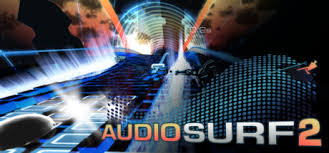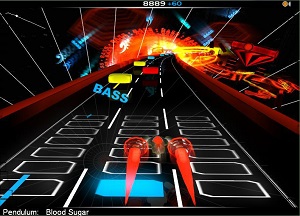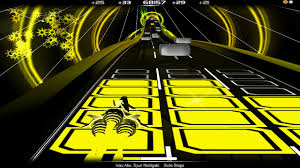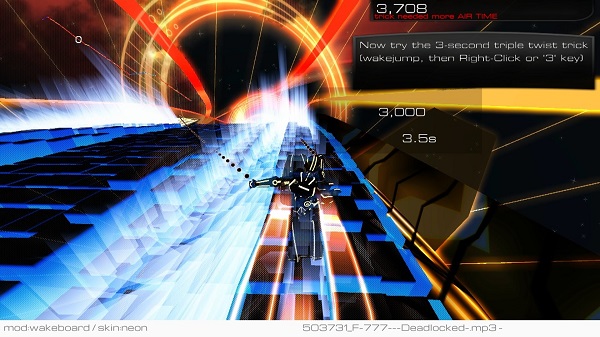 The original Audiosurf is an enduring example of how even the most humble releases can benefit from timing. Hitting Steam in February 2008, it arrived just as Valve’s online platform started to truly take off in popularity. Bolstered by tight gameplay and its being the first third-party game to use Steamworks, the game was a massive hit, taking full advantage of Steam’s ever-expanding sales schedule to position itself as the perennial Steam bargain.
The original Audiosurf is an enduring example of how even the most humble releases can benefit from timing. Hitting Steam in February 2008, it arrived just as Valve’s online platform started to truly take off in popularity. Bolstered by tight gameplay and its being the first third-party game to use Steamworks, the game was a massive hit, taking full advantage of Steam’s ever-expanding sales schedule to position itself as the perennial Steam bargain.
It also happened to be a great little game, allowing players to ‘play’ their music with a directness no other music-based game had been able to achieve, with a song’s every beat, dip and swell translated into game levels that undulated exactly with the track as it played. Combined with simple game modes, it made for one of the best rhythm games ever made and the perfect way to brush up on the less-listened to corners of your music folder.
 A sequel was inevitable, was initially announced as Audiosurf Air, then pretty much disappeared only to crop up again as a Steam early access title last October as Audiosurf 2. The initial release was something of a disappointment, with a rough and unwieldy menu system, a new mode, Wakeboarding, forced onto players with the popular modes from the first game stuck behind unlocks and an overly-busy graphical style that lacked the first game’s focused aesthetic.
A sequel was inevitable, was initially announced as Audiosurf Air, then pretty much disappeared only to crop up again as a Steam early access title last October as Audiosurf 2. The initial release was something of a disappointment, with a rough and unwieldy menu system, a new mode, Wakeboarding, forced onto players with the popular modes from the first game stuck behind unlocks and an overly-busy graphical style that lacked the first game’s focused aesthetic.
Just over six months later, the game has improved even if it still feel like it has some way to go. The UI has been vastly improved, with all modes available from the start – a good move, because Wakeboarding , which scores the player via a tricky and slow-moving jump mechanic, lacked the compulsive simplicity of the original modes. Audiosurf‘s signature mode Mono returns, taking a simple concept – pick up coloured blocks and avoid grey ones – and combining them with the song-generated tracks to create a gloriously unified experience. Other modes, such as the fun puzzle-style Pusher, also return.
 Graphically, the game also seems less cluttered than on initial release, with the blocks a little easier to discern from each other. But by and large, the best additions to Audiosurf 2 come from the game’s Steam Workshop integration. There you can download a range of single and multiplayer modes (including the fun Dodge mode, which has you avoiding all blocks instad of collecting them), and some excellent player and level skins. Ever felt like flying Mass Effect‘s Normandy through the Green Hill Zone to the song of your choice? Well now you can, and it’s every bit as fun as you’d imagine.
Graphically, the game also seems less cluttered than on initial release, with the blocks a little easier to discern from each other. But by and large, the best additions to Audiosurf 2 come from the game’s Steam Workshop integration. There you can download a range of single and multiplayer modes (including the fun Dodge mode, which has you avoiding all blocks instad of collecting them), and some excellent player and level skins. Ever felt like flying Mass Effect‘s Normandy through the Green Hill Zone to the song of your choice? Well now you can, and it’s every bit as fun as you’d imagine.
 Overall though, Audiosurf 2 still needs work before it can stand up to the original as an overall package starting with making the leaderboards reliable. The game still routinely fails to pull down leaderboard information at the end of a level, which is completely inexcusable for a score attack-based game. Audiosurf veterans will have fun playing around with this new one, but would be advised to not uninstall the original just yet if they care about highscores, while newcomers should probably just start with the first game: it’s on sale most of the time (often for little more than a couple of bucks), has huge and reliable leaderboards and is a wonderfully tight and playable game. Audiosurf 2 has the potential to supercede it, but still needs a fair degree of honing before it’ll get to that level. Otherwise, the $14.99 asking price is recommended for fans only (Though it is on sale on Steam for $8.99 until May 31st, which may be a more attractive price point for the curious).
Overall though, Audiosurf 2 still needs work before it can stand up to the original as an overall package starting with making the leaderboards reliable. The game still routinely fails to pull down leaderboard information at the end of a level, which is completely inexcusable for a score attack-based game. Audiosurf veterans will have fun playing around with this new one, but would be advised to not uninstall the original just yet if they care about highscores, while newcomers should probably just start with the first game: it’s on sale most of the time (often for little more than a couple of bucks), has huge and reliable leaderboards and is a wonderfully tight and playable game. Audiosurf 2 has the potential to supercede it, but still needs a fair degree of honing before it’ll get to that level. Otherwise, the $14.99 asking price is recommended for fans only (Though it is on sale on Steam for $8.99 until May 31st, which may be a more attractive price point for the curious).
If all this gives you the impression that developer Dylan Fitterer seems to be struggling to follow up the first game, it’s at least an understandable situation: the original Audiosurf is a wonderfully tight piece of work, both in execution and concept, and new additions like Wakeboarding struggle because they overextrapolate – and therefore dilute – the formula that makes Audiosurf so gripping. However, adding polish and allowing for Workshop additions is setting Audiosurf 2 on the right track; one only hopes that it comes together soon or it might run the risk of losing the momentum generated by its predecessor.
